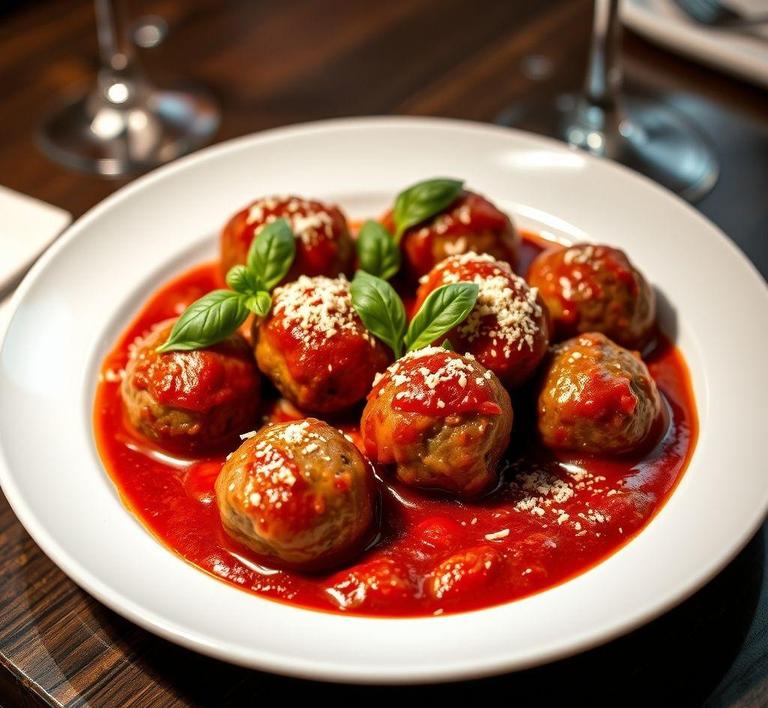If you’re a fan of meal prepping or just love making a big batch of meatballs, you may be wondering if you can refreeze meatballs and sauce once they’ve been cooked. Well, the answer is yes, but with a few important tips to keep in mind! Refreezing meatballs and sauce can save you time and effort down the road, but you need to make sure they’re stored properly to maintain their flavor and texture. In this guide, we’ll walk you through the best methods for freezing, thawing, and reheating your meatball and sauce combo so that you can enjoy a delicious, hassle-free meal whenever you want!
Can You Refreeze Meatballs And Sauce?

When it comes to meal prep or leftovers, the idea of refreezing food can be a bit tricky. You might be wondering, “Can I refreeze meatballs and sauce”? Well, the answer is a qualified yes, but it’s important to consider the method and timing involved to ensure the best results.
The first thing to know is that meatballs and sauce are a combination of protein (meat) and liquid, both of which react differently to freezing and thawing. While refreezing is possible, it’s not something you can do haphazardly. For example, if meatballs have been thawed for an extended period or exposed to bacteria, refreezing is not safe. This can lead to a loss of quality or even foodborne illness if consumed later.
The key to refreezing meatballs and sauce lies in how it was originally frozen and how it’s thawed. If they were frozen properly to begin with and not kept out for too long, it is usually safe to refreeze the mixture. However, the more times meatballs and sauce are frozen and thawed, the higher the likelihood that their texture, flavor, and overall quality will degrade.
In short, while it’s possible, it’s crucial to follow best practices for freezing and thawing to maintain both food safety and taste.
How To Refreeze Meatballs And Sauce?
Refreezing meatballs and sauce involves a few simple yet important steps to ensure safety and preserve their flavor. Here’s a detailed guide on how to do it correctly:
-
Initial Freezing Process:
If you haven’t already frozen the meatballs and sauce, make sure to follow the correct steps when you first freeze them. After cooking, let the meatballs cool down to room temperature. Never place hot food directly into the freezer, as this can lead to uneven freezing and a possible increase in bacterial growth.
-
Packaging:
It’s essential to store the meatballs and sauce in airtight containers or heavy-duty freezer bags. If using a container, leave a little space at the top to allow for expansion as the contents freeze. If using freezer bags, remove as much air as possible to prevent freezer burn.
-
Freezing:
Place the meatballs and sauce in the freezer as quickly as possible. Rapid freezing helps preserve the integrity of the food. Try to keep the meatballs in a single layer for the first few hours, as this allows them to freeze evenly.
-
Thawing:
When it’s time to use the frozen meatballs and sauce, thaw them safely. The best way to do this is by placing them in the refrigerator overnight. Thawing in the refrigerator helps prevent bacteria from growing while ensuring a more even defrosting process.
-
Refreezing After Thawing:
If you plan to refreeze meatballs and sauce after thawing, you should do so within a short period (usually 1-2 days). Never leave thawed meatballs at room temperature for more than 2 hours, as bacteria multiply quickly at these temperatures.
Once thawed, check the meatballs and sauce for any signs of spoilage (off smells, discoloration, etc.). If everything seems fine, you can proceed to refreeze.
-
Repackaging (Optional):
After thawing, you may want to consider repackaging the meatballs and sauce before refreezing, especially if you only need a portion of them. Portioning out smaller servings before freezing again will make it easier to thaw only what you need later.
Quality Impact
When it comes to refreezing meatballs and sauce, the quality can be noticeably affected, particularly if the refreezing process is repeated multiple times. Here’s a breakdown of how the quality may change:
-
Texture:
Both the meatballs and the sauce can suffer from a change in texture. Freezing causes water in the meat to expand and break down cell walls. When you thaw and refreeze meatballs, this damage accumulates. The result can be a soggy or crumbly texture. The sauce, especially if it contains dairy (like cream or cheese), may separate and become watery or curdled.
-
Flavor:
Meatballs and sauce, like many other dishes, lose some of their flavor after multiple freezes. This is because freezing doesn’t just preserve the food; it also slows down the process of oxidation. When thawed and refrozen, flavors can be duller or less vibrant, especially if the meatballs have absorbed some of the sauce during the freezing process.
-
Appearance:
The visual appeal of meatballs and sauce can diminish with each freezing and thawing cycle. Meatballs might shrink or lose their shape, and the sauce might become less smooth or grainy. Freezer burn can also cause an unsightly, dried-out appearance.
-
Moisture Loss:
The biggest concern with refreezing is moisture loss. Each time you thaw and refreeze meatballs and sauce, more moisture is lost. The sauce might thin out, and the meatballs might lose their juicy, tender texture. To help mitigate this, you can try adding a bit of fresh broth or sauce when reheating.
-
Nutrient Loss:
Though freezing doesn’t remove all the nutrients from food, the longer it’s stored or the more times it’s frozen and thawed, the greater the potential for nutrient loss. Meatballs made with lean meat or vegetables might lose a bit of their nutritional value through repeated freezing and thawing.
Refreezing meatballs and sauce is entirely possible, but it requires careful attention to detail in terms of safety and quality. While the process can be convenient for meal prep or leftover management, it’s important to know that the food’s texture, flavor, and overall appeal may suffer with each freeze-thaw cycle.
To refreeze meatballs and sauce with minimal quality loss, make sure to freeze them properly initially, thaw them in the refrigerator, and avoid leaving them out at room temperature for too long. Refreezing is best done within a day or two of thawing to ensure the safest and most flavorful outcome. Although refrozen meatballs and sauce may not be as perfect as when they were freshly made, they can still serve as a practical, time-saving option for later meals.
If you’re looking to preserve the best quality, it’s often a good idea to limit the number of times you freeze and thaw, portion out smaller servings for easier reheating, and be mindful of the type of ingredients in your sauce. With the right care, refreezing can be a useful way to avoid waste while still enjoying your favorite dishes.
Is It Safe To Refreeze Meatballs And Sauce?
Refreezing meatballs and sauce is a common question, especially when it comes to meal prep or storing leftovers. The short answer is yes, it can be safe to refreeze meatballs and sauce, but it requires careful handling to ensure both safety and quality. Refreezing involves taking food that has been thawed and then returning it to a frozen state, and this process can sometimes compromise the flavor, texture, and nutritional value. However, if you follow proper guidelines, you can refreeze your meatballs and sauce without risking foodborne illness or significant quality loss.
The key to refreezing meatballs and sauce safely lies in how they were initially handled and thawed. First, it’s important that they were frozen properly the first time. If meatballs and sauce were thawed in the fridge and not at room temperature, they can typically be refrozen with minimal risk. However, if they were thawed on the counter or in hot water, the danger of bacterial growth increases dramatically, and you should avoid refreezing.
Signs That Meatballs And Sauce Should Not Be Refrozen
There are several warning signs that meatballs and sauce should not be refrozen. These indicators mostly revolve around improper storage or the potential for bacterial contamination:
- Extended Time in the Danger Zone: The danger zone refers to temperatures between 40°F (4°C) and 140°F (60°C), where bacteria grow most rapidly. If your meatballs and sauce have been sitting out at room temperature for more than two hours (or one hour in hot weather), they should not be refrozen. This is especially true for perishable foods like meat, where bacteria can multiply exponentially.
- Unusual Odors: If your meatballs or sauce have developed a sour, off, or rancid smell, this is a clear indication of spoilage. When meat starts to break down, it releases unpleasant odors as bacteria and enzymes degrade the proteins. Refreezing spoiled food will only preserve that bad state and could increase your chances of foodborne illness.
- Discoloration: Meatballs or sauce that have turned an unusual color-especially grayish or greenish hues-may have spoiled. While a slight change in color doesn’t necessarily mean that the food is unsafe, significant discoloration often suggests bacterial growth or oxidation, which makes refreezing a risk.
- Loss of Texture or Consistency: Meatballs that have become mushy, or sauce that has separated into watery layers, may be compromised in texture. While this doesn’t always mean the food is unsafe, it’s a sign that the quality has deteriorated, and refreezing may further affect the texture, making it less appetizing.
- Freezer Burn: Freezer burn is caused by air exposure, which dries out food and causes it to lose flavor and moisture. If your meatballs or sauce are covered in freezer burn, it doesn’t make them unsafe to eat, but they may lose flavor and texture once reheated. Refreezing them after freezer burn can exacerbate these problems.
Common Refreezing Mistakes
There are several pitfalls that people commonly fall into when attempting to refreeze meatballs and sauce. Let’s look at some of the most frequent mistakes:
- Refreezing After Improper Thawing: The biggest mistake people make is thawing food improperly. If you defrost your meatballs and sauce in hot water or at room temperature, you’ve allowed bacteria to thrive in the danger zone. Always thaw frozen food in the refrigerator or by using a microwave or stovetop, and never refreeze anything that has been thawed improperly.
- Not Storing Properly Before Refreezing: If meatballs and sauce are stored in a container that isn’t airtight, they’re more susceptible to freezer burn. Air exposure can also lead to the development of ice crystals, which damage the texture and flavor. Using freezer-safe bags or containers is essential for maintaining quality when refreezing.
- Refreezing Multiple Times: Some people might be tempted to repeatedly freeze and thaw their food. However, each cycle of freezing and thawing can degrade the quality of the meatballs and sauce, affecting texture and taste. Additionally, each time you thaw food, you give bacteria a chance to multiply, which can lead to food safety issues.
- Refreezing Large Portions: Another mistake is refreezing large portions of meatballs and sauce in one batch. If you have a massive block of frozen food, it will take longer to thaw and refreeze, increasing the chances for bacterial growth. It’s better to portion the food out before freezing it so you can thaw only what you need.
- Not Labeling or Dating: It’s easy to forget when you froze the meatballs and sauce, which can lead to eating food that’s past its safe storage time. Always label your frozen items with the date they were frozen. This helps ensure that you use them within a safe period, generally 3-4 months for optimal quality.
Tips And Tricks
To make sure your meatballs and sauce are safely refrozen and still delicious, here are some tips:
- Freeze in Small Portions: Instead of freezing large batches, freeze meatballs and sauce in smaller portions. This allows you to thaw only what you need, avoiding the risk of refreezing multiple times. You can use freezer-safe containers, bags, or even ice cube trays for sauce to freeze it in manageable portions.
- Use the Right Containers: For long-term freezing, use containers designed specifically for the freezer. Opt for airtight containers or heavy-duty freezer bags. If you use freezer bags, remove as much air as possible to minimize the risk of freezer burn.
- Cool Properly Before Freezing: Allow your meatballs and sauce to cool completely before freezing them. Placing hot food directly into the freezer can cause ice crystals to form, which affects texture. To cool down quickly, let the food sit at room temperature for about 30 minutes before transferring it to the freezer.
- Use a Vacuum Sealer: If you want to preserve the food’s freshness as much as possible, invest in a vacuum sealer. This helps remove air from the bag and creates a much tighter seal than regular freezer bags, significantly reducing the risk of freezer burn.
- Freeze Sauce Separately: If possible, freeze the sauce and meatballs separately. This allows you to thaw each component according to your needs and prevents the sauce from making the meatballs soggy during the thawing process.
- Label and Date Everything: This may sound simple, but it’s essential. Label each container with the contents and the date it was frozen. This ensures you can track how long the food has been in the freezer and use it before it loses flavor and texture.
Conclusion
Refreezing meatballs and sauce is generally safe, but it requires careful attention to food safety practices. The primary concerns are how the food was thawed, how it’s stored, and how often it’s subjected to freezing and thawing cycles. By paying close attention to these factors-especially avoiding the danger zone and ensuring proper storage-you can safely refreeze your meatballs and sauce while maintaining both flavor and texture.
Avoiding common refreezing mistakes, like improper thawing or not using airtight containers, can go a long way in preserving the quality of your dish. By following the tips outlined above, you can enjoy your homemade meatballs and sauce for longer, whether you’re meal prepping for the future or simply storing leftovers for another day. Just remember to trust your senses-if the food smells or looks off, it’s better to err on the side of caution and avoid refreezing. Ultimately, with the right precautions, you can safely enjoy your refrozen meatballs and sauce without compromising quality or safety.


